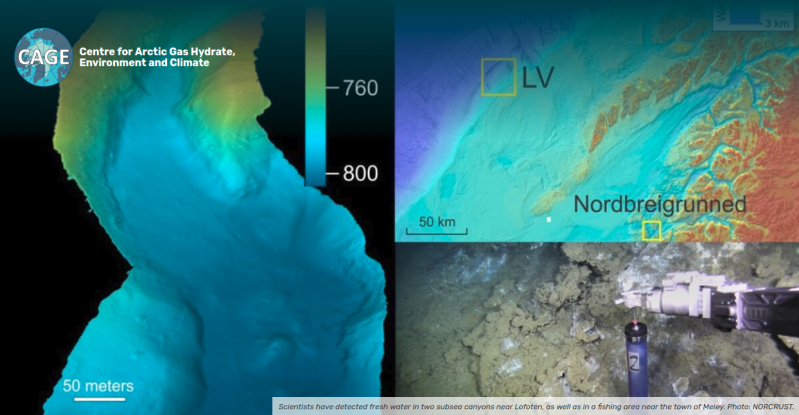Freshwater Found in the Norwegian Sea
Published on by Water Network Research, Official research team of The Water Network in Technology
The discovery was made at 800 meters below the surface in two small canyons on the continental slope outside Lofoten.

An underwater craft takes samples of fresh water leaking from the seabed. Photo: NORCRUST, Source: CAGE
‘When we the found freshwater leaking from the seabed, we were very surprised,’ explains scientist and marine geologist Wei-Li Hong at the Geological Survey of Norway (NGU) and CAGE .
A remote-controlled vehicle, deployed from research vessel G.O. Sars, collected and measured the water during an expedition in 2017. The leakage likely originated from a large pocket of freshwater, otherwise known as an aquifer, hidden beneath the sediment of the seabed.
Remnants of the last Ice Age
‘Fisherman in Nordland county have told us that they also found fresh water in the sea, so pure that it could even be used for coffee. This was in Nordbreigrunnen, a few kilometers outside the town of Meløy,’ Hong claims.
This phenomenon probably began during the last Ice Age. The thick ice caps that enveloped Norway pushed down on the crust of the Earth with tremendous force, squeezing large amounts of meltwater down through cracks in the seabed.
‘This is a geological process that began millions of years ago when the water became trapped under the sediment. Only now is it finding its way through the cracks and faults again,’ Hong says.
The water was found around a kilometer below the seabed, but the aquifer itself could be deeper, and scientists at NGU are unsure how much freshwater remains.
Similar conditions found in the United States
Scientists from Columbia University in New York and the Woods Hole Oceanographic Institution in Massachusetts recently found freshwater in the Atlantic Ocean as well, along the east coast of the United States.
‘It’s the exact same phenomenon that we have here in Norway,’ comments project manager and CAGE co-director Jochen Knies.
The Atlantic Ocean aquifer extends along the coast from the southern tip of New Jersey to the northern end of Massachusetts. According to CNN, researchers estimated that it contains enough water to fill 1.1 billion swimming pools. This makes it the largest underwater freshwater aquifer found on Earth.
A possible resource
The findings in Norway and the US suggest that there may be other such aquifers elsewhere in the world.
‘Such large pockets of fresh water could be a potential resource in areas with no drinking water on land,’ Knies points out.
The research performed in Norway is under the umbrella of the project «Norwegian margin fluid systems and methane-derived carbonate crusts» (NORCRUST), which is funded by the Research Council of Norway through the Petromaks 2 program.
The results were recently published in the scientific journal Geophysical Research Letters:
Hong, W.‐L., Lepland, A., Himmler, T., Kim, J.‐H., Chand, S., Sahy, D., et al "Discharge of meteoric water in the eastern Norwegian Sea since the last glacial period", Geophysical Research Letters, July 2019, DOI: 10.1029/2019GL084237
Source: Centre for Arctic Gas Hydrate, Environment and Climate (CAGE)
Media
Taxonomy
- Freshwater
- Oceanographic Survey